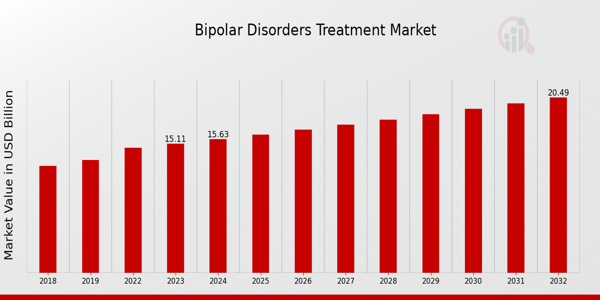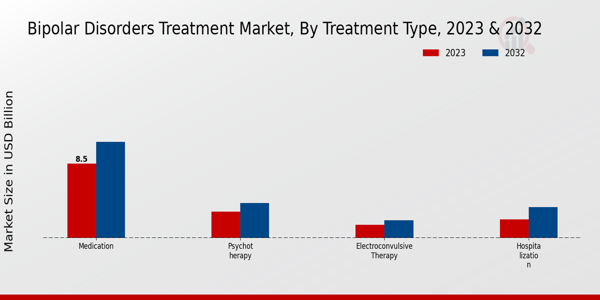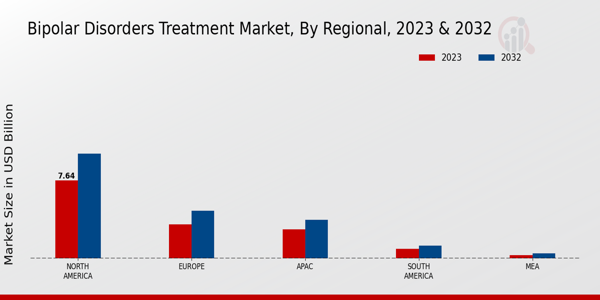Bipolar Disorders Treatment Market Overview
As per MRFR analysis, the Bipolar Disorders Treatment Market Size was estimated at 4.37 (USD Billion) in 2023. The Bipolar Disorders Treatment Market is expected to grow from 4.62 (USD Billion) in 2024 to 8.5 (USD Billion) by 2035. The Bipolar Disorders Treatment Market CAGR (growth rate) is expected to be around 5.7% during the forecast period (2025 - 2035).
Key Market Trends
The rising number of diagnosed cases and increased awareness of mental health issues have been driving significant developments in the global market for bipolar disorder treatment. The increasing frequency of bipolar illnesses in a variety of demographics, which is being driven by governments and health organizations around the world placing a greater emphasis on mental health, is one of the major market drivers. As a result, more money is now available for the study and creation of efficient cures, encouraging the development of novel pharmacological treatments such as mood stabilizers, antipsychotics, and psychosocial therapies.
The creation of individualized treatment plans that address the needs of each patient and increase the efficacy of therapies is one opportunity that should be investigated. Better patient monitoring and prompt treatment modifications are made possible by the growing use of telemedicine and digital health solutions. Furthermore, there is a greater emphasis on education and preventative care, which attempts to lower the chance of relapses and enhance patients' quality of life.
Recent trends point to a move toward integrated care approaches, in which primary care physicians and mental health specialists work together to treat bipolar disease holistically. With the backing of government programs to encourage general wellness, the integration of mental health services into general healthcare systems is becoming more and more important in many parts of the world. A future with better management options is also being hinted at by ongoing clinical trials and research initiatives that aim to address unmet requirements in the treatment of bipolar illness.
People with bipolar illnesses can live in a more supportive environment because of this holistic approach, which reflects a global commitment to improving mental health outcomes.

Source: Primary Research, Secondary Research, MRFR Database and Analyst Review
Bipolar Disorders Treatment Market Drivers
Increasing Prevalence of Bipolar Disorders
The 'Global Bipolar Disorders Treatment Market' is witnessing a significant increase in the number of individuals diagnosed with bipolar disorders. According to the World Health Organization (WHO), approximately 60 million people globally are affected by this mental health condition. Over the past decade, there has been a noted increase of around 10% in the incidence rates of bipolar disorder. This has been observed in many regions, driven by increased awareness and better diagnostic techniques.
The rise in diagnosis is fueling the demand for effective treatment options, creating favorable conditions for growth in the Global Bipolar Disorders Treatment Market. Organizations such as the National Institute of Mental Health (NIMH) and Mental Health Foundation are actively working towards improving recognition and treatment pathways for bipolar disorder, influencing healthcare policies and funding dedicated to mental health services globally.
Advancements in Treatment Modalities
The Global Bipolar Disorders Treatment Market is significantly motivated by innovative advancements in treatment modalities. New pharmaceutical formulations and therapies, along with psychotherapeutic approaches, are emerging as effective treatments for bipolar disorder. The development of long-acting injectable medications is particularly noteworthy, as they can enhance adherence to treatment protocols. According to the American Psychiatric Association, up to 50% of patients with bipolar disorder do not adhere to their medication regimen, leading organizations to push for more innovative treatment options.
These advancements are projected to invigorate the market as new therapies enter the pipeline, creating a pathway for further growth in the Global Bipolar Disorders Treatment Market.
Rising Awareness and Education about Mental Health
Increasing awareness and education on mental health contribute positively to the growth of the Global Bipolar Disorders Treatment Market. Campaigns and educational programs organized by entities like the World Federation for Mental Health and national health departments are making strides in reducing the stigma associated with mental illness. Recent surveys indicate that public awareness about bipolar disorders has increased by approximately 20% over the last five years. This improved understanding aids in timely diagnosis and initiates effective treatment, creating a supportive environment for patients.
As society fosters an understanding of mental health, more individuals are likely to seek treatment, driving market expansion.
Bipolar Disorders Treatment Market Segment Insights
Bipolar Disorders Treatment Market Treatment Type Insights
The global bipolar disorders treatment market, segmented by treatment type, showcased a diverse array of approaches to addressing the complexities of this mental health condition. Among the various treatment options, Medication took the lead, valued at 2.0 USD Billion in 2024, and projected to grow to 3.6 USD Billion by 2035. This segment played a crucial role as it included mood stabilizers, antipsychotics, and antidepressants, which are essential in managing the symptoms of bipolar disorder and stabilizing the patient's mood.
Following closely was the Psychotherapy segment, with a valuation of 1.2 USD Billion expected in 2024, increasing to 2.1 USD Billion in 2035. Psychotherapy was significant as it offered therapeutic techniques that were fundamental in developing coping strategies and enhancing patients' overall well-being. Hospitalization, valued at 0.8 USD Billion in 2024 and 1.4 USD Billion in 2035, often became necessary for severe cases where patients are at risk of harming themselves or others, highlighting its importance in the critical phases of treatment.
Electroconvulsive Therapy (ECT), valued at 0.3 USD Billion in 2024 and projected to rise to 0.7 USD Billion by 2035, served as a life-saving treatment for those who did not respond well to medication. Lastly, Transcranial Magnetic Stimulation (TMS) appeared as a more recent addition to the treatment landscape, with an initial value of 0.32 USD Billion in 2024, seeing a rise to 0.6 USD Billion by 2035.
This non-invasive procedure gained traction as an effective alternative treatment, particularly for patients who preferred non-pharmacological interventions. The combination of these various Treatment Types within the Global Bipolar Disorders Treatment Market not only reflects the diversified approach to mental health care but also addresses the unique needs of bipolar disorder patients, ultimately enhancing their chances for successful long-term management.
As the market progresses, the significance of each segment becomes crucial in understanding the broader context of mental health treatment on a global scale, where the integration of Medication, Psychotherapy, Hospitalization, Electroconvulsive Therapy, and Transcranial Magnetic Stimulation plays a vital role in creating well-rounded treatment plans.

Source: Primary Research, Secondary Research, MRFR Database and Analyst Review
Bipolar Disorders Treatment Market Medication Class Insights
The Global Bipolar Disorders Treatment Market focuses significantly on the Medication Class segment. By 2035, this market is expected to experience considerable growth, reflecting the overall increasing demand for effective treatment options. Within this segment, Mood Stabilizers play a crucial role in managing mood swings, making them a preferred choice among healthcare providers. Antipsychotics are also prominent, as they help control manic episodes, which significantly impacts patient management strategies.
Antidepressants are integral for addressing depressive episodes in patients with bipolar disorders, while Anticonvulsants are increasingly recognized for their mood-stabilizing properties. The market has been driven by a rising prevalence of bipolar disorders globally, alongside heightened awareness of mental health issues. However, challenges include the complex nature of treatment adherence and side effects associated with medications. Opportunities lie in the development of personalized medicine approaches and innovative therapies, indicating a positive trajectory for the Global Bipolar Disorders Treatment Market revenue.
The segmentation of this market is critical as it highlights the diversity in treatment strategies tailored to individual patient needs, promoting better outcomes in clinical practice.
Bipolar Disorders Treatment Market Patient Age Group Insights
The Global Bipolar Disorders Treatment Market is segmented by patient age group, which plays a critical role in understanding treatment approaches and market dynamics. Children, adolescents, adults, and the elderly each face unique challenges regarding bipolar disorders, and targeted treatment solutions are becoming increasingly important. The segment concerning adolescents is particularly significant, as early intervention during teenage years can lead to better long-term outcomes.
Adults currently dominate the market, reflecting higher diagnosis rates and a broader array of treatment options. The elderly segment is also gaining attention due to the rising incidence of late-onset bipolar disorder, addressing the unique complexities of managing mental health in older age. Overall, the Global Bipolar Disorders Treatment Market segmentation based on patient age group reveals diverse treatment needs and opportunities for innovative therapies tailored to each demographic, ultimately contributing to the market growth as it caters to these varying requirements.
Bipolar Disorders Treatment Market Healthcare Setting Insights
The Global Bipolar Disorders Treatment Market within the Healthcare Setting is poised for significant growth. Within this framework, the healthcare settings can be categorized into various categories that cater to different patient needs. Outpatient services are increasingly preferred, allowing patients to receive treatment while continuing daily activities, which plays a crucial role in managing bipolar disorder effectively. Inpatient treatments are essential for patients experiencing severe episodes, providing intensive support and monitoring.
Additionally, Residential Treatment Centers offer a structured environment for individuals needing longer-term care. This multi-faceted approach to treatment reflects the need for coordinated care aimed at improving patient outcomes and matching diverse patient requirements. Trends such as increased awareness of mental health, advancements in medication, and emphasis on personalized care contribute to the evolving landscape of the Global Bipolar Disorders Treatment Market, which presents multiple opportunities despite challenges in access and cost.
Understanding Global Bipolar Disorders Treatment Market data helps stakeholders address these variables to serve patients better.
Bipolar Disorders Treatment Market Regional Insights
The Global Bipolar Disorders Treatment Market showed a robust presence across different regions, contributing significantly to overall growth. In 2024, North America dominated the market with a valuation of 2.15 USD Billion, increasing to 4.0 USD Billion by 2035, thus holding a majority share due to growing awareness and improved access to healthcare services. Europe followed with a valuation of 1.25 USD Billion in 2024 and is expected to reach 2.3 USD Billion by 2035, benefiting from progressive healthcare policies and advanced treatment options.
The APAC region, valued at 0.85 USD Billion in 2024 and estimated to grow to 1.6 USD Billion by 2035, showcased a significant potential driven by increasing patient populations and a rising emphasis on mental health. Meanwhile, South America and the Middle East and Africa (MEA) represented smaller, yet important markets, valued at 0.25 USD Billion and 0.12 USD Billion respectively in 2024, with expected growth reflecting a rising acknowledgment of bipolar disorders and their treatment needs.
The overall market reflects trends driven by increasing mental health awareness yet faces challenges such as stigma and limited resources in certain regions, highlighting opportunities for growth in mental health services and innovative treatment options through the Global Bipolar Disorders Treatment Market data and industry dynamics.

Source: Primary Research, Secondary Research, MRFR Database and Analyst Review
Bipolar Disorders Treatment Market Key Players and Competitive Insights
In the Global Bipolar Disorders Treatment Market, competition is intensifying as the prevalence of bipolar disorder continues to rise, thereby increasing the demand for effective therapeutic solutions. This market is characterized by a blend of established pharmaceutical companies and emerging players seeking to capture market share through innovative treatment options. The competitive landscape is shaped by several factors, including the introduction of novel drugs, advancements in drug delivery systems, and strategic partnerships aimed at enhancing research and development efforts.
Companies are also focusing on patient-centric approaches, ensuring that their treatment regimens are not only effective but also address the overall quality of life for individuals living with bipolar disorder. The market dynamics are further influenced by the regulatory environment, which is increasingly adapting to the needs of mental health treatments, creating both challenges and opportunities for players in the sector.
Pfizer
Pfizer, a significant player in the Global Bipolar Disorders Treatment Market, has established a strong presence through its robust portfolio of psychiatric medications. The company is renowned for its commitment to research and development, consistently seeking to innovate and improve existing therapies. Pfizer's strength lies in its capability to leverage cutting-edge clinical trials that facilitate the introduction of effective new treatments, thereby enhancing patient outcomes.
Furthermore, Pfizer's global reach and extensive distribution network allow for the efficient delivery of its products, making them accessible to a larger patient population. The company's strategic collaborations and partnerships with healthcare providers and research institutions also position it favorably within the market, allowing for the advancement of treatment methodologies tailored to meet the specific needs of individuals diagnosed with bipolar disorder.
AbbVie
AbbVie is another key player in the Global Bipolar Disorders Treatment Market, focusing on research-driven approaches to address the complexities of mental health disorders. The company has made notable strides through its innovative therapies that target various aspects of bipolar disorder, showcasing its dedication to improving patient care globally. In addition to its core portfolio, which includes several significant medications, AbbVie has strategically pursued mergers and acquisitions that enhance its capabilities and expand its therapeutic offerings.
By incorporating advanced technologies and insights from acquired entities, AbbVie strengthens its market presence and amplifies its research capabilities. This strategic expansion not only diversifies its product range but also enhances its ability to respond to evolving patient needs, ensuring that it remains competitive in the marketplace. Through these initiatives, AbbVie continues to establish itself as a leader in bipolar disorder treatment, committed to fostering advancements that benefit the global mental health landscape.
Key Companies
Key Companies in the Bipolar Disorders Treatment Market Include: Pfizer AbbVie Roche Otsuka Pharmaceutical Johnson and Johnson GSK H. Lundbeck A/S Teva Pharmaceutical Industries Novartis Mylan N.V. Bristol-Myers Squibb AstraZeneca Amgen Eli Lilly and Company Sanofi
Bipolar Disorders Treatment Market Developments
The Global Bipolar Disorders Treatment Market has seen significant developments recently, particularly with major pharmaceutical companies like Pfizer and AbbVie enhancing their product offerings. Pfizer has focused on expanding the accessibility of its treatment options, while AbbVie has been engaged in Research and Development activities to innovate its drug portfolio. In recent months, Otsuka Pharmaceutical has reported a rise in market valuation due to increased demand for its novel therapeutics, whereas Johnson and Johnson has strengthened its commitment to mental health treatments.
Notably, in September 2023, GSK announced a partnership to develop new treatment modalities, signaling a strategic shift towards personalized medicine in bipolar disorder. Additionally, H. Lundbeck A/S and Teva Pharmaceutical Industries have been actively involved in mergers, with reports emerging of a potential collaboration aimed at consolidating R&D efforts and resource allocation. The increasing prevalence of bipolar disorder globally creates a formidable need for effective solutions, pushing companies like Eli Lilly and Company and Novartis to enhance their competitive edge through strategic expansions and technological advancements in therapeutic practices.
The overall market is projected to grow significantly based on these developments and heightened consumer awareness of mental health issues.
Bipolar Disorders Treatment Market Segmentation Insights
Bipolar Disorders Treatment Market Treatment Type Outlook
- Medication
- Psychotherapy
- Hospitalization
- Electroconvulsive Therapy
- Transcranial Magnetic Stimulation
Bipolar Disorders Treatment Market Medication Class Outlook
- Mood Stabilizers
- Antipsychotics
- Antidepressants
- Anticonvulsants
Bipolar Disorders Treatment Market Patient Age Group Outlook
- Children
- Adolescents
- Adults
- Elderly
Bipolar Disorders Treatment Market Healthcare Setting Outlook
- Outpatient
- Inpatient
- Residential Treatment Centers
Bipolar Disorders Treatment Market Regional Outlook
- North America
- Europe
- South America
- Asia Pacific
- Middle East and Africa
| Report Attribute/Metric Source: |
Details |
| MARKET SIZE 2023 |
4.37(USD Billion) |
| MARKET SIZE 2024 |
4.62(USD Billion) |
| MARKET SIZE 2035 |
8.5(USD Billion) |
| COMPOUND ANNUAL GROWTH RATE (CAGR) |
5.7% (2025 - 2035) |
| REPORT COVERAGE |
Revenue Forecast, Competitive Landscape, Growth Factors, and Trends |
| BASE YEAR |
2024 |
| MARKET FORECAST PERIOD |
2025 - 2035 |
| HISTORICAL DATA |
2019 - 2024 |
| MARKET FORECAST UNITS |
USD Billion |
| KEY COMPANIES PROFILED |
Pfizer, AbbVie, Roche, Otsuka Pharmaceutical, Johnson and Johnson, GSK, H. Lundbeck A/S, Teva Pharmaceutical Industries, Novartis, Mylan N.V., BristolMyers Squibb, AstraZeneca, Amgen, Eli Lilly and Company, Sanofi |
| SEGMENTS COVERED |
Treatment Type, Medication Class, Patient Age Group, Healthcare Setting, Regional |
| KEY MARKET OPPORTUNITIES |
Innovative drug development, Digital therapeutic solutions, Personalized medicine approaches, Increased awareness and diagnosis, Emerging markets expansion |
| KEY MARKET DYNAMICS |
Rising prevalence of mood disorders, Growing awareness and diagnosis, Advancements in treatment options, Increasing investments in research, Changing stigma around mental health |
| COUNTRIES COVERED |
North America, Europe, APAC, South America, MEA |
Bipolar Disorders Treatment Market Highlights:
Frequently Asked Questions (FAQ) :
The Global Bipolar Disorders Treatment Market is expected to be valued at 4.62 USD Billion in 2024.
By 2035, the Global Bipolar Disorders Treatment Market is anticipated to reach a valuation of 8.5 USD Billion.
The projected CAGR for the Global Bipolar Disorders Treatment Market between 2025 to 2035 is 5.7%.
North America is expected to dominate the Global Bipolar Disorders Treatment Market, valued at 2.15 USD Billion in 2024.
The North American market for bipolar disorders treatment is anticipated to grow to 4.0 USD Billion by 2035.
The medication segment of the Global Bipolar Disorders Treatment Market is projected to be valued at 3.6 USD Billion by 2035.
Key players in the Global Bipolar Disorders Treatment Market include Pfizer, AbbVie, and Roche among others.
The psychotherapy segment of the Global Bipolar Disorders Treatment Market is valued at 1.2 USD Billion in 2024.
The APAC region is expected to be valued at 0.85 USD Billion in the Global Bipolar Disorders Treatment Market in 2024.
The hospitalization segment is expected to grow to 1.4 USD Billion by 2035 in the Global Bipolar Disorders Treatment Market.


















